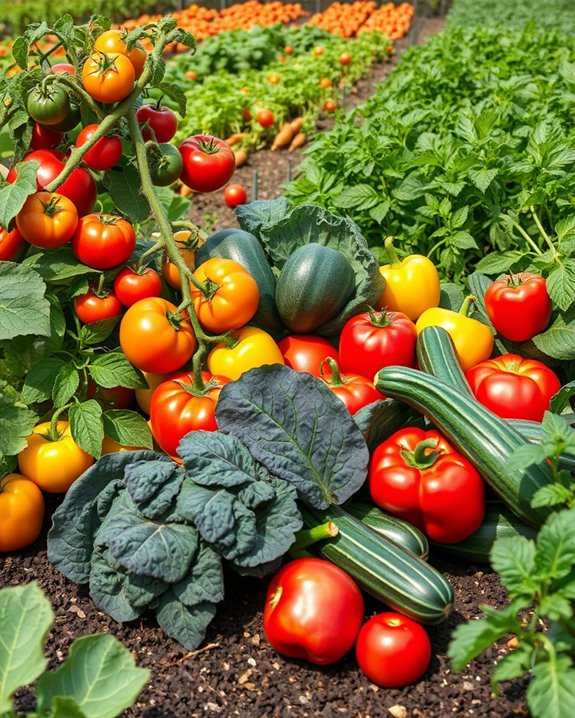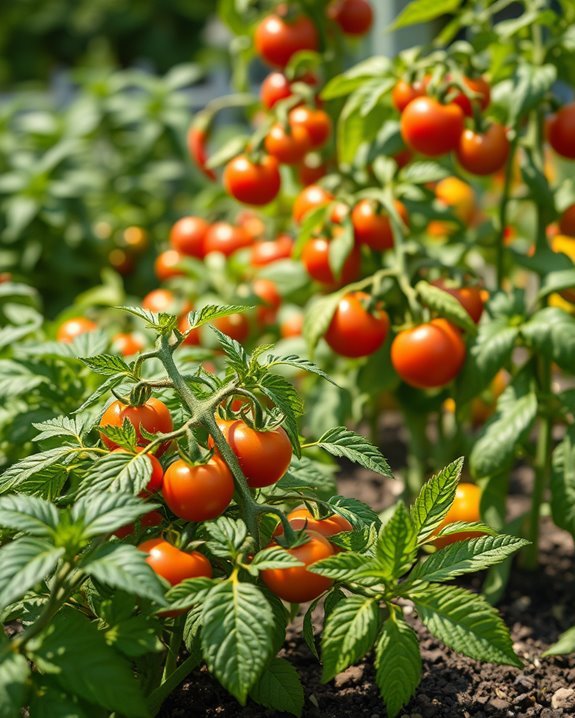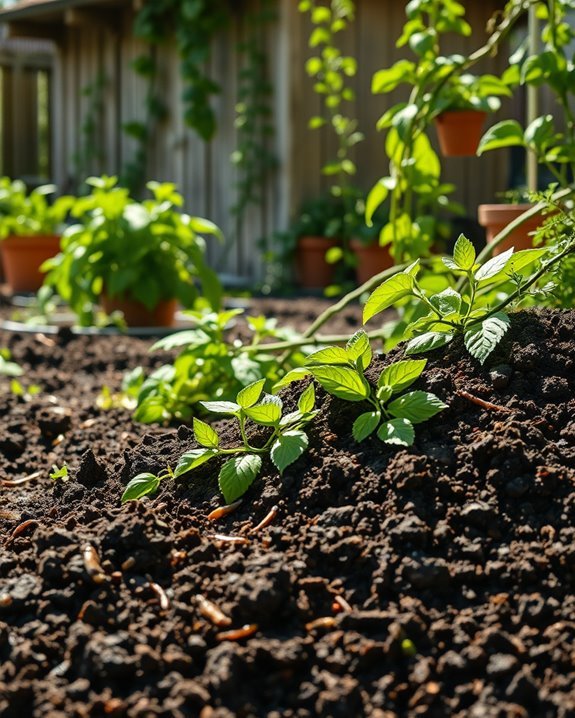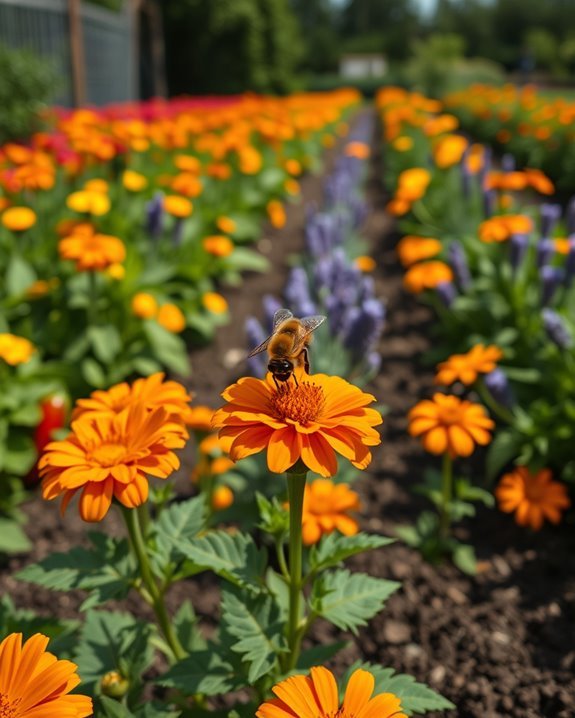40 Garden Vegetable Ideas for Bigger Yields
To boost your vegetable garden’s yield, start by choosing high-yield hybrids and disease-resistant varieties. Utilize companion planting to attract beneficial insects and fend off pests. Implement vertical gardening and square foot gardening to maximize your space. Don’t forget to time your planting around frost dates and select drought-resistant plants. Spacing your plants for ideal airflow is essential too. There’s so much more you can do to enhance your gardening success, so keep exploring these strategies!
Choosing High-Yield Vegetable Varieties

When you’re planning your garden, choosing high-yield vegetable varieties can make all the difference in your harvest.
Opt for high yield hybrids, which often produce more fruits and resist pests better than traditional varieties.
However, don’t overlook heirloom varieties; they offer unique flavors and traits that can enhance your garden.
Balancing both types can maximize your yield and diversify your crops.
Companion Planting Strategies

Choosing the right vegetable varieties is just the beginning; how you plant them together can greatly impact your garden’s success.
Implement companion planting strategies by creating effective planting patterns that encourage beneficial insects. For instance, pairing tomatoes with basil can deter pests, while attracting pollinators helps your crops thrive.
Pay attention to these combinations to maximize your yields and garden health.
Utilizing Vertical Gardening Techniques

Whether you have limited space or simply want to enhance your garden’s aesthetic, utilizing vertical gardening techniques can transform your growing experience.
By incorporating trellis designs, wall planters, and hanging baskets, you can maximize vertical space and optimize your garden height.
Consider using vertical planters for climbing vegetables and creative plant arrangements to make the most of your container gardening efforts.
Implementing Crop Rotation

After maximizing your vertical space with climbing vegetables and creative arrangements, it’s time to think about how to maintain soil health and improve crop yields.
Implementing crop rotation enhances soil fertility by alternating plant families, which helps restore nutrients. This practice also aids in pest management, as rotating crops disrupts pest life cycles, reducing infestations and ensuring a healthier garden overall.
Maximizing Space With Square Foot Gardening

If you’re looking to make the most of your gardening space, square foot gardening offers an efficient and organized approach.
By utilizing a square foot layout, you can maximize plant density, allowing you to grow more in less space.
This method helps you plan your garden systematically, ensuring each square foot is used effectively for higher yields and healthier plants.
Enhancing Soil Quality With Compost

To cultivate thriving garden vegetables, enhancing soil quality with compost is essential.
Compost benefits your garden by improving soil structure, increasing nutrient levels, and promoting beneficial microorganisms.
By incorporating compost as a key soil amendment, you create a rich environment for your plants to flourish.
Regularly adding compost not only boosts yields but also enhances the overall health of your garden soil.
Incorporating Mulching for Moisture Retention

While you focus on growing vibrant vegetables, incorporating mulching can greatly enhance moisture retention in your garden.
Different mulch types, like straw, wood chips, or grass clippings, help maintain ideal moisture levels by reducing evaporation.
Timing Planting for Optimal Growth

Timing your planting can greatly influence the growth and yield of your vegetables.
Consider early sowing to take advantage of the growing season, but be mindful of the last frost date to guarantee your plants thrive.
Using frost protection methods, like row covers, can help safeguard tender seedlings.
Adopting Succession Planting Methods

Once you’ve mastered the timing of your initial plantings, adopting succession planting methods can further enhance your garden’s productivity.
By implementing crop scheduling, you can stagger your planting intervals, ensuring a continuous harvest throughout the season.
This technique not only maximizes space but also allows you to enjoy fresh vegetables over an extended period, keeping your garden thriving and fruitful.
Understanding Sunlight Requirements

How can you guarantee your vegetables thrive in the garden? Understanding sunlight requirements is key.
Most vegetables need at least six hours of sunlight exposure daily, while some can tolerate partial shade. Knowing the shade tolerance of your plants helps you position them effectively.
Using Raised Beds for Better Drainage

Along with sunlight, proper drainage plays an essential role in vegetable gardening success.
Using raised beds enables you to control soil amendments and improve drainage. Choose raised bed materials like untreated wood or metal for durability.
Elevating your garden not only prevents waterlogging but also warms the soil faster, promoting healthier root systems and bigger yields.
Happy gardening!
Implementing Drip Irrigation Systems

Implementing a drip irrigation system can revolutionize the way you water your garden.
By focusing on proper drip emitter placement, you’ll guarantee that each plant receives the right amount of water directly at the roots.
Regular system maintenance is key, too; check for clogs and leaks to keep everything running smoothly.
With a little effort, you’ll boost your garden’s productivity considerably.
Selecting Disease-Resistant Varieties

When you choose disease-resistant varieties for your garden, you’re setting yourself up for greater success and fewer headaches later on.
Focus on variety selection that offers strong disease resistance, as these plants are less likely to succumb to common garden ailments.
This proactive approach not only boosts your yields but also saves you time and effort in managing diseases throughout the growing season.
Intercropping for Increased Diversity

Intercropping can greatly enhance the diversity and productivity of your garden. By using strategic crop combinations, you can maximize space and resources while boosting plant diversity.
For example, pairing fast-growing crops with slower ones allows for better light and nutrient utilization. This method not only increases yields but also improves pest control and soil health, making your garden more resilient and sustainable.
Pruning Techniques for Higher Yields

To further boost the productivity of your garden, mastering pruning techniques can make a significant difference in your yields.
Leaf pruning helps direct energy to fruit production, while tip pruning encourages bushier growth.
By regularly removing excess leaves and cutting back the tips of stems, you’ll promote healthier plants that produce more abundant crops throughout the growing season.
Get pruning for better harvests!
Fertilizing With Organic Amendments

While many gardeners rely on chemical fertilizers for quick results, using organic amendments can greatly enhance soil health and plant vigor.
Incorporate organic fertilizers like compost tea and mineral supplements to improve nutrient cycling.
Microbial inoculants and biochar benefits boost soil life, while green manures enrich the soil.
These natural soil amendments create a thriving environment for your garden vegetables.
Utilizing Green Manures and Cover Crops

Building on the benefits of organic amendments, utilizing green manures and cover crops can considerably improve soil fertility and structure.
By planting legumes or other green manure options, you’ll enhance nitrogen levels and organic matter.
Additionally, cover crops like clover or rye can prevent erosion and suppress weeds.
Embrace these practices to maximize your garden’s health and yield potential.
Managing Pests Naturally

As you cultivate your garden, managing pests naturally becomes essential for maintaining a healthy ecosystem.
Use natural repellents like neem oil or garlic spray to deter unwanted insects.
Encourage beneficial insects, such as ladybugs and lacewings, which prey on harmful pests.
Enhancing Pollination With Attractants

To create a thriving garden, enhancing pollination can greatly boost your vegetable yields.
Planting flowering plants around your garden attracts beneficial pollinators like bees and butterflies.
Create pollinator habitats by including diverse blooms that flower at different times, ensuring a steady food source.
Using Shade Cloth for Temperature Control

Shade cloth acts like a protective shield for your garden, helping to regulate temperatures and safeguard your plants from the harsh sun.
By using shade cloth, you’ll enjoy shade cloth benefits like reduced heat stress, extended growing seasons, and enhanced crop yields.
It’s an effective way to guarantee your plants thrive, especially during those scorching summer days when temperature regulation is essential.
Building a Compost Bin for Nutrients

Creating a compost bin is a fantastic way to enrich your garden soil with essential nutrients.
By incorporating kitchen scraps and yard waste, you can start the decomposition process.
Consider adding worms for worm composting, which accelerates nutrient breakdown.
Once your compost is ready, you can brew compost tea to provide your plants with a nutrient-rich liquid boost.
Happy composting!
Employing Hydroponic Systems

While traditional gardening relies on soil, employing hydroponic systems allows you to grow plants in a soil-less environment, making it easier to control nutrients and water.
You’ll enjoy hydroponic benefits like faster growth and higher yields. By using carefully balanced nutrient solutions, you can provide your plants with exactly what they need, leading to healthier, more vibrant vegetables in less time.
Exploring Aquaponics for Sustainability

As you explore sustainable gardening options, aquaponics stands out as a synergistic system that combines aquaculture and hydroponics.
By integrating fish into your aquaponic systems, you promote nutrient cycling while conserving water. These closed loop systems foster symbiotic relationships, ideal for urban aquaponics.
Embracing these eco-friendly gardening practices enhances food security and showcases effective water conservation techniques for a sustainable future.
Timing Harvest for Peak Flavor

To truly savor the vibrant flavors of your garden vegetables, timing your harvest is essential.
Use effective harvest techniques to pick vegetables at their peak ripeness, maximizing their flavor profiles. For instance, tomatoes taste best when fully colored, while leafy greens are sweetest when young and tender.
Planting in Containers for Flexibility

Have you considered how planting in containers can transform your gardening experience?
Container gardening offers flexibility, letting you grow vegetables in limited spaces. With portable planters, you can easily move your plants to capture sunlight or protect them from harsh weather.
This adaptability not only maximizes your yield but also enhances your gardening enjoyment, allowing you to create a thriving green space anywhere.
Creating a Microclimate in the Garden

Creating a microclimate in your garden can greatly boost your vegetable growth, especially when you’ve already embraced the flexibility of container gardening.
To enhance microclimate creation, group your plants together and use structures like trellises or fences for windbreaks. These methods help with temperature regulation, keeping your veggies warmer in cooler months and cooler during heat waves, ensuring healthier yields.
Using Floating Row Covers

While you might think of row covers as just another gardening tool, using floating row covers can considerably protect your vegetable plants from pests and harsh weather.
These covers create a barrier that helps with temperature regulation, keeping plants warmer in cool weather and cooler during hot spells.
Selecting Fast-Growing Vegetable Varieties

Which fast-growing vegetable varieties should you consider for your garden?
Look for fast maturing crops like radishes, lettuce, and green beans that thrive in shorter growing seasons.
These quick harvest vegetables not only provide fresh produce but also keep your garden productive.
Incorporating Herbs for Companion Benefits

Incorporating herbs into your vegetable garden not only enhances flavor but also offers significant companion benefits that can boost your overall yield.
For instance, basil’s herb benefits include repelling pests while promoting healthier tomatoes.
Similarly, rosemary can enhance the growth of beans.
Experiment with various herb pairings, and you’ll notice improved resilience and flavor in your crops, maximizing your garden’s potential.
Exploring Perennial Vegetables

If you’re looking to create a low-maintenance garden, exploring perennial vegetables is a fantastic option.
Asparagus benefits include yielding delicious spears for years with minimal effort.
Pair it with perennial herbs like chives and oregano, which come back each season, adding flavor to your meals.
These choices not only save you time but also enhance your garden’s productivity year after year.
Utilizing Cold Frames for Extended Seasons

While the weather may turn chilly, you can still enjoy fresh vegetables year-round by utilizing cold frames.
These structures provide numerous cold frame benefits, like improved temperature regulation, allowing you to extend your growing season.
By trapping heat and protecting plants from harsh conditions, cold frames enable you to harvest flavorful vegetables even when outdoor temperatures drop.
Embrace this gardening technique for bigger yields!
Creating a Pollinator-Friendly Garden

Creating a pollinator-friendly garden not only supports essential bees, butterflies, and other pollinators, but it also enhances the beauty and productivity of your outdoor space.
To attract these beneficial creatures, choose pollinator plants, especially native species that thrive in your region.
Utilizing Soil Testing for Nutrient Needs

Understanding your garden’s soil is essential for growing healthy vegetables, as it directly affects nutrient availability and plant growth.
Conducting a soil nutrient analysis helps you identify deficiencies that could hinder your plants. Look for nutrient deficiency signs like yellowing leaves or stunted growth.
Implementing Companion Flowers for Pest Control

By incorporating companion flowers into your garden, you can naturally deter pests and promote a healthier growing environment for your vegetables.
Marigolds, for example, serve as effective pest deterrents against aphids and nematodes.
Planting these flower companions near your crops not only enhances beauty but also creates a thriving ecosystem that benefits both your flowers and vegetables, ensuring bigger yields.
Building a Garden Trellis for Climbing Plants

When you want to maximize your garden’s vertical space, building a trellis for climbing plants can be a game changer.
Choose a trellis design that suits your garden’s style and the types of plants you’re growing.
Use effective climbing techniques, like tying vines to the trellis or using netting, to support your plants.
This approach not only saves space but also boosts your yields!
Using Heat Mats for Seed Germination

Using heat mats for seed germination can greatly enhance your gardening success, especially during cooler months.
These mats provide consistent warmth, ensuring your seedling temperature stays ideal for growth. By maintaining the right conditions, you’ll boost germination rates considerably.
Place your trays on the mats and watch as your seeds sprout faster, leading to healthier plants ready for transplanting.
Timing Planting Around Frost Dates

After ensuring your seeds germinate successfully with heat mats, the next step is timing your planting around frost dates.
Check your local frost dates to avoid planting too early or too late. Use these dates to create planting schedules tailored to your garden.
This allows crops to thrive without the risk of frost damage, ultimately leading to bigger yields.
Selecting Drought-Resistant Varieties

As you plan your garden, selecting drought-resistant varieties can make a significant difference in your success, especially during dry spells.
Focus on native plant selection; these plants are better adapted to your local climate and require less water.
Additionally, prioritize soil moisture management techniques, like mulching and deep watering, to help your drought-resistant vegetables thrive while conserving precious water resources.
Spacing Plants for Maximum Airflow

To guarantee healthy plant growth, aim for adequate spacing between your vegetables. This secures maximum airflow benefits, reducing the risk of diseases and promoting stronger plants.
Consider using interplanting techniques to optimize your garden layout, allowing companion plants to thrive without crowding each other. By prioritizing space, you’ll enhance light penetration and air circulation, ultimately boosting your vegetable yields.
Regularly Monitoring Plant Health

Keeping an eye on your plants is essential for a thriving garden.
Look for plant symptoms like yellowing leaves or stunted growth, as these can indicate nutrient deficiencies.
Regularly inspecting your plants helps you catch issues early, allowing you to adjust your care routine.
Conclusion
By exploring these 40 garden vegetable ideas, you can boost your yields and enjoy a bountiful harvest. Remember to choose high-yield varieties, utilize companion planting, and implement vertical gardening to maximize space. Don’t forget to time your planting around frost dates and select drought-resistant plants for resilience. With proper spacing for airflow and regular health monitoring, you’ll be well on your way to a thriving garden. Get started today, and watch your garden flourish!







